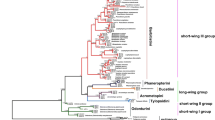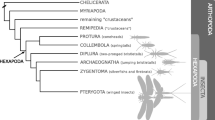Abstract
Flightin is a thick filament protein that in Drosophila melanogaster is uniquely expressed in the asynchronous, indirect flight muscles (IFM). Flightin is required for the structure and function of the IFM and is indispensable for flight in Drosophila. Given the importance of flight acquisition in the evolutionary history of insects, here we study the phylogeny and distribution of flightin. Flightin was identified in 69 species of hexapods in classes Collembola (springtails), Protura, Diplura, and insect orders Thysanura (silverfish), Dictyoptera (roaches), Orthoptera (grasshoppers), Pthiraptera (lice), Hemiptera (true bugs), Coleoptera (beetles), Neuroptera (green lacewing), Hymenoptera (bees, ants, and wasps), Lepidoptera (moths), and Diptera (flies and mosquitoes). Flightin was also found in 14 species of crustaceans in orders Anostraca (water flea), Cladocera (brine shrimp), Isopoda (pill bugs), Amphipoda (scuds, sideswimmers), and Decapoda (lobsters, crabs, and shrimps). Flightin was not identified in representatives of chelicerates, myriapods, or any species outside Pancrustacea (Tetraconata, sensu Dohle). Alignment of amino acid sequences revealed a conserved region of 52 amino acids, referred herein as WYR, that is bound by strictly conserved tryptophan (W) and arginine (R) and an intervening sequence with a high content of tyrosines (Y). This motif has no homologs in GenBank or PROSITE and is unique to flightin and paraflightin, a putative flightin paralog identified in decapods. A third motif of unclear affinities to pancrustacean WYR was observed in chelicerates. Phylogenetic analysis of amino acid sequences of the conserved motif suggests that paraflightin originated before the divergence of amphipods, isopods, and decapods. We conclude that flightin originated de novo in the ancestor of Pancrustacea > 500 MYA, well before the divergence of insects (~400 MYA) and the origin of flight (~325 MYA), and that its IFM-specific function in Drosophila is a more recent adaptation. Furthermore, we propose that WYR represents a novel myosin coiled-coil binding motif.





Similar content being viewed by others
Reference
Ayer G, Vigoreaux JO (2003) Flightin is a myosin rod binding protein. Cell Biochem Biophys 38:41–54
Ayme-Southgate AJ, Southgate RJ, Philipp RA, Sotka EE, Kramp C (2008) The myofibrillar protein, projectin, is highly conserved across insect evolution except for its PEVK domain. J Mol Evol 67:653–669
Barton B, Ayer G, Heymann N, Maughan DW, Lehmann FO, Vigoreaux JO (2005) Flight muscle properties and aerodynamic performance of Drosophila expressing a flightin transgene. J Exp Biol 208:549–560
Barua B, Pamula MC, Hitchcock-DeGregori SE (2011) Evolutionarily conserved surface residues constitute actin binding sites of tropomyosin. Proc Natl Acad Sci USA 108:10150–10155
Brodsky AK (1994) The evolution of insect flight. Oxford University Press, Oxford
Carapelli A, Lio P, Nardi F, van der Wath E, Frati F (2007) Phylogenetic analysis of mitochondrial protein coding genes confirms the reciprocal paraphyly of Hexapoda and Crustacea. BMC Evol Biol 7(Suppl 2):S8.1471–S8.2148. doi:10.1186/1471-2148-7-S2-S8
Chakravorty S (2013) Role of the Drosophila melanogaster indirect flight muscles in flight and male courtship song: studies on flightin and myosin light chain-2. Biology. Ph.D. thesis, Burlington, University of Vermont, 339 pp
Chan WP, Dickinson MH (1996) In vivo length oscillations of indirect flight muscles in the fruit fly Drosophila virilis. J Exp Biol 199:2767–2774
Contompasis JL, Nyland LR, Maughan DW, Vigoreaux JO (2010) Flightin is necessary for length determination, structural integrity, and large bending stiffness of insect flight muscle thick filaments. J Mol Biol 395:340–348
Dohle W (2001) Are the insects terrestrial crustaceans? A discussion of some new facts and arguments and the proposal of the proper name ‘Tetraconata’ for the monophyletic unit Crustacea+Hexapoda. Annales de la Societe Entomologique de France 37:85–103
Domazet-Loso T, Tautz D (2003) An evolutionary analysis of orphan genes in Drosophila. Genome Res 13:2213–2219
Douglas SE (1995) DNA Strider. An inexpensive sequence analysis package for the Macintosh. Mol Biotechnol 3:37–45
Dudley R (2000) The biomechanics of insect flight. Princeton University Press, Princeton
Dunn CW, Hejnol A, Matus DQ et al (2008) Broad phylogenomic sampling improves resolution of the animal tree of life. Nature 452:745–749
Ferguson C, Lakey A, Hutchings A, Butcher GW, Leonard KR, Bullard B (1994) Cytoskeletal proteins of insect muscle: location of zeelins in Lethocerus flight and leg muscle. J Cell Sci 107:1115–1129
Flashman E, Watkins H, Redwood C (2007) Localization of the binding site of the C-terminal domain of cardiac myosin-binding protein-C on the myosin rod. Biochem J 401:97–102
Giribet G, Edgecombe GD (2012) Reevaluating the arthropod tree of life. Annu Rev Entomol 57:167–186
Grimaldi DA (2010) 400 million years on six legs: on the origin and early evolution of Hexapoda. Arthropod Struct Dev 39:191–203
Grimaldi D, Engel MS (2005) Evolution of the insects. Cambridge University Press, Cambridge
Henkin JA, Maughan DW, Vigoreaux JO (2004) Mutations that affect flightin expression in Drosophila alter the viscoelastic properties of flight muscle fibers. Am J Physiol Cell Physiol 286:C65–C72
Hyatt CJ, Maughan DW (1994) Fourier analysis of wing beat signals: assessing the effects of genetic alterations of flight muscle structure in Diptera. Biophys J 67:1149–1154
Jenner RA (2010) Higher-level crustacean phylogeny: consensus and conflicting hypotheses. Arthropod Struct Dev 39:143–153
Kreis T, Vale R (eds) (1999) Guidebook to the cytoskeletal and motor proteins. Oxford University Press, Oxford
Kronert WA, O’Donnell PT, Fieck A, Lawn A, Vigoreaux JO, Sparrow JC, Bernstein SI (1995) Defects in the Drosophila myosin rod permit sarcomere assembly but cause flight muscle degeneration. J Mol Biol 249:111–125
Macagno ER, Gaasterland T, Edsall L et al (2010) Construction of a medicinal leech transcriptome database and its application to the identification of leech homologs of neural and innate immune genes. BMC Genomics 11:407. doi:10.1186/1471-2164-11-407
Maddison WP, Maddison DR (2002) MacClade: analysis of phylogeny and character evolution, version 4.05 for Mac OS X. Sinauer, Sunderland
Mallatt JM, Garey JR, Shultz JW (2004) Ecdysozoan phylogeny and Bayesian inference: first use of nearly complete 28S and 18S rRNA gene sequences to classify the arthropods and their kin. Mol Phylogenet Evol 31:178–191
Marck C (1988) ‘DNA Strider’: a ‘C’ program for the fast analysis of DNA and protein sequences on the Apple Macintosh family of computers. Nucleic Acids Res 16:1829–1836
Maughan D, Vigoreaux J (2004) Nature’s strategy for optimizing power generation in insect flight muscle. In: Sugi H (ed) Mysteries about the sliding filament mechanism: fifty years after its proposal. Plenum Press, New York
Miller MS, Tanner BCW, Nyland L, Vigoreaux JO (2010) Comparative biomechanics of thick filaments and thin filaments with functional consequences for muscle contraction. J Biomed Biotech 2010:14. doi:10.1155/2010/473423
Miyamoto CA, Fischman DA, Reinach FC (1999) The interface between MyBP-C and myosin: site-directed mutagenesis of the CX myosin-binding domain of MyBP-C. J Muscle Res Cell Motil 20:703–715
Moore JR (2006) Stretch activation: toward a molecular mechanism. In: Vigoreaux JO (ed) Nature’s versatile engine: insect flight muscle inside and out. Springer/Landes Biosci, New York, pp 44–60
Nardi F, Spinsanti G, Boore JL, Carapelli A, Dallai R, Frati F (2003) Hexapod origins: monophyletic or paraphyletic? Science 299:1887–1889
Nongthomba U, Cummins M, Clark S, Vigoreaux JO, Sparrow JC (2003) Suppression of muscle hypercontraction by mutations in the myosin heavy chain gene of Drosophila melanogaster. Genetics 164:209–222
Nyland LR, Palmer BM, Chen Z, Maughan DW, Seidman CE, Seidman JG, Kreplak L, Vigoreaux JO (2009) Cardiac myosin binding protein-C is essential for thick-filament stability and flexural rigidity. Biophys J 96:3273–3280
Obermann WM, Gautel M, Weber K, Furst DO (1997) Molecular structure of the sarcomeric M band: mapping of titin and myosin binding domains in myomesin and the identification of a potential regulatory phosphorylation site in myomesin. EMBO J 16:211–220
Qiu F, Brendel S, Cunha PM, Astola N, Song B, Furlong EE, Leonard KR, Bullard B (2005) Myofilin, a protein in the thick filaments of insect muscle. J Cell Sci 118:1527–1536
Reedy MC, Bullard B, Vigoreaux JO (2000) Flightin is essential for thick filament assembly and sarcomere stability in Drosophila flight muscles. J Cell Biol 151:1483–1499
Regier JC, Shultz JW, Kambic RE (2005) Pancrustacean phylogeny: hexapods are terrestrial crustaceans and maxillopods are not monophyletic. Proc Biol Sci 272:395–401
Regier JC, Shultz JW, Zwick A, Hussey A, Ball B, Wetzer R, Martin JW, Cunningham CW (2010) Arthropod relationships revealed by phylogenomic analysis of nuclear protein-coding sequences. Nature 463:1079–1083
Richter S (2002) The Tetraconata concept: hexapod-crustacean relationships and the phylogeny of Crustacea. Org Divers Evol 2:217–237
Ronquist F, Teslenko M, van der Mark P et al (2012) MrBayes 3.2: efficient Bayesian phylogenetic inference and model choice across a large model space. Syst Biol 61:539–542
Ruiz-Trillo I, Paps J, Loukota M, Ribera C, Jondelius U, Baguna J, Riutort M (2002) A phylogenetic analysis of myosin heavy chain type II sequences corroborates that Acoela and Nemertodermatida are basal bilaterians. Proc Natl Acad Sci USA 99:11246–11251
Sheterline P, Clayton J, Sparrow J (1998) Actin. Oxford University Press, Oxford
Tanner BC, Miller MS, Miller BM, Lekkas P, Irving TC, Maughan DW, Vigoreaux JO (2011) C-terminal truncation of flightin decreases myofilament lattice organization, cross-bridge binding, and power output in Drosophila indirect flight muscle. Am J Physiol Cell Physiol 301:C383–C391
Thompson JD, Higgins DG, Gibson TJ (1994) CLUSTAL W: improving the sensitivity of progressive multiple sequence alignment through sequence weighting, position-specific gap penalties and weight matrix choice. Nucleic Acids Res 22:4673–4680
Vigoreaux JO (1994) Alterations in flightin phosphorylation in Drosophila flight muscles are associated with myofibrillar defects engendered by actin and myosin heavy chain mutant alleles. Biochem Genet 32:301–314
Vigoreaux JO, Saide JD, Valgeirsdottir K, Pardue ML (1993) Flightin, a novel myofibrillar protein of Drosophila stretch-activated muscles. J Cell Biol 121:587–598
Vigoreaux JO, Hernandez C, Moore J, Ayer G, Maughan D (1998) A genetic deficiency that spans the flightin gene of Drosophila melanogaster affects the ultrastructure and function of the flight muscles. J Exp Biol 201:2033–2044
Wang Y, Zhang X, Zhang H et al (2012) Coiled-coil networking shapes cell molecular machinery. Mol Biol Cell 23:3911–3922
Wilson EO (1992) The diversity of life. W. W. Norton & Company, New York
Acknowledgments
This research was supported by National Science Foundation awards IOS-0718417 and MCB-1050834 to JOV. FNSA was supported in part by Grant HL007944 from the National Institutes of Health. PAO was supported in part by NSF 0450339 AGEP. We thank Jesus G. Valenzuela and Claudio Meneses, Laboratory of Malaria and Vector Research, National Institute of Allergy and Infectious Diseases, for providing Lutzomya, and members of the Vigoreaux and Maughan labs for helpful discussions.
Author information
Authors and Affiliations
Corresponding author
Electronic supplementary material
Below is the link to the electronic supplementary material.
Rights and permissions
About this article
Cite this article
Soto-Adames, F.N., Alvarez-Ortiz, P. & Vigoreaux, J.O. An Evolutionary Analysis of Flightin Reveals a Conserved Motif Unique and Widespread in Pancrustacea. J Mol Evol 78, 24–37 (2014). https://doi.org/10.1007/s00239-013-9597-5
Received:
Accepted:
Published:
Issue Date:
DOI: https://doi.org/10.1007/s00239-013-9597-5




